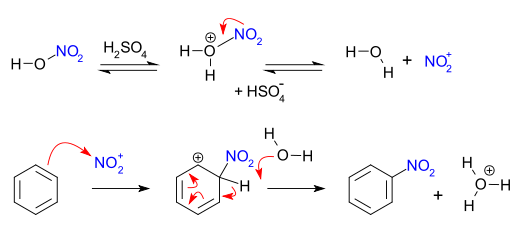- Nitration
-
Nitration is a general chemical process for the introduction of a nitro group into a chemical compound. The dominant application of nitration is for the production of nitrobenzene, the precursor to methylene diphenyl diisocyanate. Nitrations are famously used for the production of explosives, for example the conversion of glycerin to nitroglycerin and the conversion of toluene to trinitrotoluene. Millions of tons of nitroaromatics are produced annually.[1]
Contents
Aromatic nitration
Typical nitrations use nitric acid and sulfuric acid, so-called "mixed acid.".[2] This mixture produces the nitronium ion (NO2+), which is the active species in aromatic nitration. This active ingredient, which can be isolated in the case of nitronium tetrafluoroborate,[3] also effects nitration without the need for the mixed acid. The sulfuric acid is not consumed and hence acts as a catalyst as well as an absorbent for water. In the case of nitration of benzene, the reaction is conducted at 50 °C. The process is one example of electrophilic aromatic substitution, which involve the attack of the electron-rich benzene ring:
Alternative mechanisms have also been proposed, including one involving single electron transfer (SET).[4][5]
Scope
Selectivity can be a challenge in nitrations. Depending on conditions, fluorenone can be selective trinitrated[6] or tetranitrated.[7] Another example of trinitration can be found in the synthesis of phloroglucinol.
The substituents on aromatic rings affect the rate of this electrophilic aromatic substitution. Deactivating groups such as other nitro groups have an electron-withdrawing effect. Such groups deactivate (slow) the reaction and directs the electrophilic nitronium ion to attack the aromatic meta position. Deactivating meta-directoring substituents include sulfonyl, cyano groups, keto, esters, and carboxylates. Nitration can be accelerated by activating groups such as amino, hydroxy and methyl groups also amides and ethers resulting in para and ortho isomers.
The direct nitration of aniline with nitric acid and sulfuric acid, according to one source [8] results in a 50/50 mixture of para and meta nitroaniline. In this reaction the fast-reacting and activating aniline (ArNH2) exists in equilibrium with the more abundant but less reactive (deactivated) anilinium ion (ArNH3+), which may explain this reaction product distribution. According to another source [9] a more controlled nitration of aniline starts with the formation of acetanilide by reaction with acetic anhydride followed by the actual nitration. Because the amide is a regular activating group the products formed are the para and ortho isomers. Heating the reaction mixture is sufficient to hydrolyze the nitroamide back to the nitroamine.
In the Wolfenstein-Boters reaction, benzene reacts with nitric acid and mercury nitrate to give picric acid.
Ipso nitration
With aryl chlorides, triflates and nonaflates ipso substitution can take place as well in so-called ipso nitration.[10] The phrase was first used by Perrin and Skinner in 1971 in an investigation into chloroanisole nitration [11] In one protocol 4-chloro-n-butylbenzene is reacted with sodium nitrite in t-butanol in presence of 0.5 mol% Pd2(dba)3 ,a biarylphosphine ligand and a phase-transfer catalyst to 4-nitro-n-butylbenzene [12]
References
- ^ Gerald Booth "Nitro Compounds, Aromatic" Ullmann's Encyclopedia of Industrial Chemistry, 2005, Wiley-VCH, Weinheim. doi:10.1002/14356007.a17_411
- ^ John McMurry Organic Chemistry 2nd Ed.
- ^ George A. Olah and Stephen J. Kuhn, "Benzonitrile, 2-methyl-3,5-dinitro-", Org. Synth., http://www.orgsyn.org/orgsyn/orgsyn/prepContent.asp?prep=cv5p0480; Coll. Vol. 5: 480
- ^ Esteves, P. M.; Carneiro, J. W. M.; Cardoso, S. P.; Barbosa, A. G. H.; Laali, K. K.; Rasul, G.; Prakash, G. K. S.; e Olah, G. A. (2003). "Unified Mechanism Concept of Electrophilic Aromatic Nitration Revisited: Convergence of Computational Results and Experimental Data". J. Am. Chem. Soc. 125 (16): 4836. doi:10.1021/ja021307w. PMID 12696903.
- ^ Queiroz, J. F.; Carneiro, J. W. M.; Sabino A. A.; Sparapan, R.; Eberlin, M. N.; Esteves, P. M. (2006). "Electrophilic Aromatic Nitration: Understanding Its Mechanism and Substituent Effects". J. Org. Chem. 71 (16): 6192. doi:10.1021/jo0609475. PMID 16872205.
- ^ E. O. Woolfolk and Milton Orchin, "2,4,7-Trinitrofluorenone", Org. Synth., http://www.orgsyn.org/orgsyn/orgsyn/prepContent.asp?prep=cv3p0837; Coll. Vol. 3: 837
- ^ Melvin S. Newman and H. Boden, "2,4,5,7-Tetranitrofluorenone", Org. Synth., http://www.orgsyn.org/orgsyn/orgsyn/prepContent.asp?prep=cv5p1029; Coll. Vol. 5: 1029
- ^ Web resource: warren-wilson.edu
- ^ Mechanism and synthesis Peter Taylor,Royal Society of Chemistry (Great Britain),Open University
- ^ Prakash, G.; Mathew, T. (2010). "Ipso-Nitration of Arenes". Angewandte Chemie (International ed. in English) 49 (10): 1726–1728. doi:10.1002/anie.200906940. PMID 20146295.
- ^ Perrin, C. L.; Skinner, G. A. (1971). "Directive effects in electrophilic aromatic substitution ("ipso factors"). Nitration of haloanisoles". Journal of the American Chemical Society 93 (14): 3389. doi:10.1021/ja00743a015.
- ^ Fors, B.; Buchwald, S. (2009). "The Pd-Catalyzed Conversion of Aryl Chlorides, Triflates, and Nonaflates to Nitroaromatics". Journal of the American Chemical Society 131 (36): 12898–12899. doi:10.1021/ja905768k. PMC 2773681. PMID 19737014. http://www.pubmedcentral.nih.gov/articlerender.fcgi?tool=pmcentrez&artid=2773681.
Categories:- Substitution reactions
Wikimedia Foundation. 2010.

